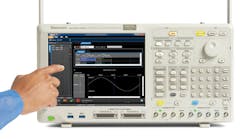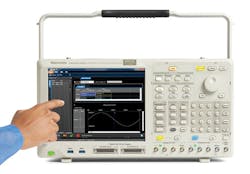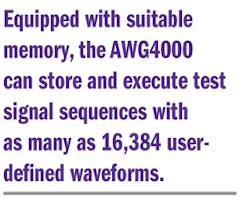Communications standards never stop evolving, forcing engineers to be quick on their feet when it comes to generating the correct test signals for a new standard. To help meet that need for speed, Tektronix developed the AWG4000 Series of arbitrary waveform generators (AWGs), which offers the flexibility desired by most users.
The AWGs can operate simply when a quick signal is required, or as a fully programmable arbitrary signal source when the need arises for the latest waveform or exotic modulation format. With multiple output channels, sampling rates to 2.5 Gsamples/s, and 14-b vertical resolution, the AWGs back up that flexibility with performance capable of characterizing the latest analog and digital circuits to 1.2 GHz and beyond.
The AWG4000 (see figure) is actually a 3-in-1 test-signal generator that can operate in basic, advanced, and digital signal modes. The compact instrument combines a high-speed direct-digital synthesizer (DDS) with a wideband AWG source. The DDS is the source of signals for the basic operating mode, with two analog output channels that can each generate sinewaves to 600 MHz at output levels to 5 V p-p.
Analog and Digital Channels × 2
The AWG can generate both analog sinewaves and different types of digital output signals when evaluating components such as digital signal processors (DSPs) and field-programmable gate arrays (FPGAs). The AWG circuitry is capable of two analog channels with as much as 750-MHz modulation bandwidth each, and two digital channels with 8-b resolution and options to increase resolution to 16 or 32 b. The AWG’s performance is noteworthy, since these are outputs featuring –60-dBc spurious-free dynamic range (SFDR).
With two digital output channels each capable of operation to 1.25 Gb/s, high-speed digital signal patterns can be created in parallel. Multiple signals are able to be time-synchronized for complex modes of testing. In addition, multiple AWG4000s can readily be synchronized and daisy-chained when a large number of synchronized test signals are needed. One marker output is provided for each analog channel for triggering and synchronization.
In some cases, such as when testing digital-to-analog converters (DACs) and analog-to-digital converters (ADCs), mixed, digital, and analog signals may be needed. To that end, the AWG4000 can synchronize analog and digital outputs in two 16-b groups: Each signal group can be configured as lower-resolution (8-b) signals at full speed (one-half the sampling rate) or higher-resolution (16-b) signals at one-quarter the sampling rate.
The AWG is based on a Windows operating system and is compatible with the firm’s versatile and networkable RFXpress test software for advanced measurement programming. Equipped with suitable memory, the AWG4000 can store and execute test signal sequences with as many as 16,384 user-defined waveforms.
Available with various feature sets, the AWG4000 is readily upgradable as test requirements change. For example, the basic configuration has two analog channels and no digital channels; it includes 1 Mpoint of memory for each analog channel, but can be upgraded to 16, 32, or 64 Mpoints. Digital channel resolution can also get an upgrade, from the basic configuration of 8 b to either 16- or 32-b resolution. P&A: $34,900 and up.
Tektronix Inc., 14200 SW Karl Braun Dr., P. O. Box 500, Beaverton, OR 97077; (877) 977-0425; www.tektronix.com.
Looking for parts? Go to SourceESB.


